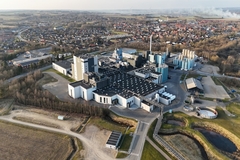
- Industry news
Industry news
- Category news
Category news
- Reports
- Key trends
- Multimedia
- Journal
- Events
- Suppliers
- Home
- Industry news
Industry news
- Category news
Category news
- Reports
- Key trends
- Multimedia
- Events
- Suppliers
Natural color innovation thrives amid tightening regulations around artificial ingredients

As consumers continue to move away from artificial ingredients and regulation around color additives and food dyes tightens, companies are innovating solutions that boost clean label credentials with natural color alternatives.
We speak to key players California Natural Colors, GNT Group, and dsm-firmenich in the natural colors space for the latest consumer trends driving innovation, and how they help manufacturers and brands overcome formulation challenges to develop solutions consumers seek.
California Natural Color (CNF) is a global supplier of premium grape juice concentrate, natural colors, and grape seed extract. Using proprietary technology, the company transforms fruit and vegetables into high-strength, natural color solutions that help brands replace synthetic colors, simplify their supply chain, and meet clean label expectations.

Speaking to Food Ingredients First, Jay Howard, color technology manager, says the company is seeing growing demand and opportunity within the beverage and confectionery spaces for natural colors.
“Bold shades are key to consumer appeal in these categories, and brands are reformulating naturally to clean up their labels and comply with evolving regulations. Opportunities are emerging in newer health-focused categories like beverage supplements, mindful snacks, and more, where natural colors can support better-for-you positioning and visual appeal,” he says.
Natural colors going mainstream
Dieuwertje Raaijmakers, marketing communications specialist at GNT Group, says there has long been a huge demand for natural colors in confectionery, soft drinks, and dairy. In many countries, they’ve now become the industry standard across nearly every category.
“There are several reasons for that. One is that consumers prefer natural products. Regulatory developments are another factor. In the EU, for example, many synthetic dyes require warning labels. The technical possibilities with plant-based colors have also improved dramatically over the years, and they’re very cost-competitive too.”
Sandro Tomita, global head of coloration at dsm-firmenich, tells us that color is central to how consumers experience food and drink. Still, some categories rely more heavily on it than others.
“Bakery and confectionery lead globally in the use of colors, each accounting for around 16% of launches last year, followed by soft drinks at 12%, and then snacks and ready meals. Within these high-color categories, we see strong momentum toward natural solutions as brands look to meet clean label expectations and reassure consumers with familiar, trusted ingredients,” he says.
“The fastest growth in color use is coming from less traditional areas. In 2024, 14% of hot drink launches featured added colors, while fruit- and vegetable-based products, and protein-rich categories, like meat substitutes, are also gaining pace. This signals that demand for color ingredients — including naturally-derived options — is no longer confined to indulgence. It is spreading into health-focused and plant-forward applications, where natural colors are becoming essential to both product differentiation and consumer acceptance.”
The GNT Group uses fresh beetroot in the Exberry colors portfolio.
Robust regulation around colors
Food dyes and color use have been in the spotlight recently, with Robert F. Kennedy Jr.’s “Make America Healthy Again” (MAHA) initiative in the US cracking down on the use of certain synthetic dyes in the food supply chain.
For Howard at CNF, the shift the industry is seeing is a greater reflection of how regulatory bodies align with consumer concerns about safety and transparency. The spotlight on synthetic dyes is pushing the industry toward more natural and transparent solutions, leading to accelerated reformulation timelines.
“For brands, this means future-proofing product development with the right partner and ingredients that help you meet current standards and evolving regulations in the US and globally. While these regulations can be challenging, California Natural Color helps navigate the transition through a collaborative process with our team of experts.”
Raaijmakers agrees that the new regulations have been challenging for manufacturers operating in the US, but flags the “huge experience replacing synthetic dyes” GNT has.
Tomita at dsm-firmenich flags the speed with which regulation is evolving, and how the FDA’s revocation of red dye No. 3 for food uses “is a major milestone.”
“Several US states are going further, proposing bans or warning labels on artificial dyes. In Latin America, countries like Mexico and Peru are restricting azo dyes, while others mandate warnings for ingredients such as tartrazine. And in Europe, scrutiny of artificial additives continues to tighten,” he says.
“This regulatory momentum is fully aligned with our values. We’re helping customers transition seamlessly to compliant, consumer-friendly solutions, backed by a portfolio centered on approved, recognizable, non-artificial ingredients. It’s also why we continue to invest in future-ready innovations like fermentation. Far from being a compliance burden, this is an opportunity to deliver healthier, lower-footprint solutions that build consumer confidence.”
Overcoming challenges
Tomita continues that natural pigments bring clear consumer advantages, but technically, they are much more complex to work with. Stability is the biggest hurdle; exposure to light, oxygen, pH changes, or heat can all lead to fading or shifts in shade.
“In beverages, issues like ringing, sedimentation, or separation can quickly undermine visual appeal. Certain packaging materials, like PET bottles, can also cause staining. By contrast, artificial dyes are chemically uniform and resilient. That’s why naturals demand deeper formulation science and application expertise to deliver the consistency manufacturers and consumers expect,” he says.
Raaijmakers agrees that achieving vibrant, stable shades with plant-based colors requires a wealth of knowledge and experience. “It’s important for color suppliers and product manufacturers to work closely to achieve optimal results.”
He cites red dye No. 3, which will be banned in the US from 2027. “A lot of red and pink color concentrates contain anthocyanin pigments — our options include black carrot, radish, red sweet potato, and many more. They’re a great option for most applications, but the pH level of the base product is important.”
“Anthocyanins appear bright red or pink in acidic environments but shift purple or blue as pH levels rise. Beet concentrates, which contain betanin pigments, are another option as they’re not affected by pH, but they are heat sensitive. It’s about selecting the best possible raw material, or blend of raw materials, and then adapting recipes where required to deliver the optimal results.”
“That might mean adjusting the pH of the base product, for example, or adding the color after the heating stage. With the right approach, you can achieve very similar shades to synthetic dyes in most cases.”
Howard notes that packaging and ingredient interactions are also important to consider, stressing that, unlike synthetic colors, natural colors are inherently more sensitive to factors like pH, heat, and light, all of which can affect vibrancy and consistency.
“As a result, while synthetic colors can often be incorporated into formulations with minimal concern, natural colors generally require thorough application testing to ensure optimal performance in each unique product matrix.”
What’s the next frontier in natural colors?
Opportunities in natural colors are predicted to grow as the regulatory space tightens further and consumers continue to push the boundaries of what they want.
Howard says that natural color innovation will likely focus on formulating colors to be more versatile and stable. “For example, using natural antioxidants can help keep colors fresh and vibrant for longer, while encapsulating agents can protect them from light, heat, and pH changes. These are just some of the methods that could help natural colors perform better in various products, making them more appealing to both manufacturers and consumers.”
“Sustainability is becoming a more important topic right across the food and drink industry, and that means there’s going to be more focus on ingredients, including colors,” adds GNT’s Raaijmakers.
“We’ve now started offering Product Carbon Footprint data across Scopes 1, 2, and 3 for the vast majority of the colors in our portfolio. We can do that because of our unique supply chain approach, which involves working closely with our contract farmers. That helps us track emissions throughout the value chain accurately to deliver reliable PCF data for our customers.”
Meanwhile, dsm-firmenich is seeing a growing demand for dual-purpose solutions, where color also brings nutritional or functional benefits.
“For example, β-carotene as a source of provitamin A. Emotional palettes are gaining ground too, with bright yellows signaling energy, and soft lavender hues offering reassurance.”
“Fermentation will be the engine that makes this possible at scale. Our Vibelly Color Solutions are only the start, proving how science, sustainability, and sensory appeal can come together in a single solution. By uniting these strengths, we’re setting the benchmark for the next generation of natural color innovation,” Tomita concludes.










